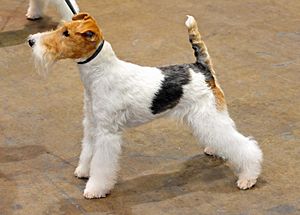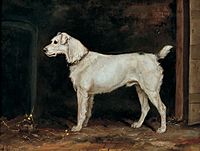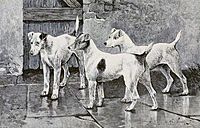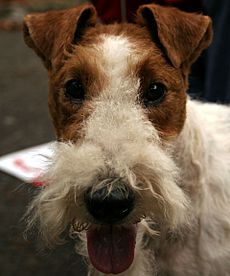Fox Terrier facts for kids
 |
|
| Other names | Smooth Fox Terrier Wire Fox Terrier |
|---|---|
| Origin | England |
| Domestic dog (Canis lupus familiaris) | |
Fox Terriers are a popular type of dog. There are actually two main kinds: the Smooth Fox Terrier and the Wire Fox Terrier. Both of these breeds came from England in the 1800s. They are related to other white terrier dogs. Some other dog breeds, like the Jack Russell Terrier and Rat Terrier, also came from these Fox Terriers.
Wire and Smooth Fox Terriers look quite similar. The biggest differences are their fur (called a coat) and their markings. These dogs have been very successful in dog shows, especially in America.
Contents
History of Fox Terriers
Early Terriers
Long ago, around 54 BC, the Romans saw small dogs in England. These dogs were used by hunters to chase animals like foxes into their underground homes. This shows the natural "going to earth" behavior of terriers.
In 1577, an English doctor named John Caius wrote about the English terrier. By the 1700s, most terriers were described as having wire hair and being black and tan in color.
The First White Terrier
The first white terrier known was a dog named Pitch. He belonged to Colonel Thomas Thornton in 1790. A famous artist, Sawrey Gilpin, even painted Pitch. People believed that Pitch was a mix of a terrier and a greyhound. This mix might have brought the white color into the breed.
How Modern Fox Terriers Developed
We don't know much about how Fox Terriers were bred in the early 1800s. But it's thought that many different dog breeds helped create them. These included the Beagle, Old English Bulldog, English Toy Terrier, Pointer, and even the Dalmatian.
From 1870 onwards, we have clear records of Fox Terrier family trees. Three dogs are considered the ancestors of most modern white terriers: Old Jock, Trap, and Tartar. Old Jock came from a black and tan terrier. Trap came from dogs owned by Reverend John "Jack" Russell. The Jack Russell Terrier breed was later named after him. Another dog, Old Tip, is thought to be an ancestor of the modern Wire Fox Terrier.
Changes in Hunting
In the past, Fox Terriers had shorter legs and chunky bodies. They were kept with English Foxhounds and used to chase foxes out of their dens. As hunting became faster, terriers were bred with longer legs for more speed. However, this made them too big for their original job. So, their use in fox hunting started to decrease.
Dog Shows and Popularity
The Fox Terrier Club of England was started in 1876. Nine years later, the American Fox Terrier Club was formed. This was the first club for a specific dog breed to join the American Kennel Club.
A Smooth Fox Terrier named Warren Remedy made history. She won "Best in Show" at the Westminster Kennel Club Dog Show three times in a row (1907, 1908, and 1909). Because dog shows became so popular, Fox Terriers were bred very carefully. For example, by 1949, most Wire Fox Terrier champions came from just one champion dog.
Modern Fox Terrier Breeds
There are two main types of Fox Terrier: Smooth and Wire. Both started in England. Many other breeds have also come from them in different countries. For example, the American Toy Fox Terrier came from the Smooth Fox Terrier mixed with other small breeds like the Italian Greyhound and Chihuahua.
Both main types of Fox Terriers are mostly white with colored patches. They have similar faces. The biggest difference is their fur. Their markings can look black when they are puppies but often lighten to tan and black as they grow up. Even though these two types were once bred together, purebred dogs are no longer mixed.
Fox Terriers have won more "Best in Show" titles at the Westminster Kennel Club Dog Show than any other breed. The Smooth Fox Terrier has won four times, and the Wire Fox Terrier has won fourteen times! Until 1985, they were shown as one breed with two fur types. Then, the American Kennel Club listed them as separate breeds. In the UK, at Crufts, the Smooth Fox Terrier hasn't won "Best in Show," but the Wire Fox Terrier has won three times.
Smooth Fox Terrier

The Smooth Fox Terrier has short, hard fur that is mostly white. It usually stands about 14 to 15.5 inches (36-39 cm) tall at the shoulder. It weighs between 15 and 19 pounds (6.8-8.6 kg). This breed has a long, wedge-shaped head with small, dark eyes and V-shaped ears.
In the UK, the Smooth Fox Terrier is considered a Vulnerable Native Breed. This means fewer than 300 puppies are registered each year with The Kennel Club. In 2010, only 155 Smooth Fox Terriers were registered. In comparison, 693 Wire Fox Terriers were registered, and over 8,000 Staffordshire Bull Terriers were registered.
The most famous Smooth Fox Terrier was Ch. Warren Remedy. She won "Best in Show" at the Westminster Kennel Club Dog Show three times (1907-1909). Another Smooth Fox Terrier, Ch. Sabine Rarebit, won in 1910. Even though Smooth Fox Terriers won the first four "Best in Show" titles at Westminster, they haven't won since.
Wire Fox Terrier
The Wire Fox Terrier has a tough, crisp outer coat and a coarse undercoat. This double coat protects them from the cold. The fur should be so thick that you can't see their skin. The individual hairs twist but are not curly. An average Wire Fox Terrier is about 14 to 15.5 inches (36-39 cm) tall and weighs between 15 and 19 pounds (6.8-8.6 kg). They have similar features to the Smooth Fox Terrier, with small dark eyes and V-shaped ears. Their body is a bit shorter than they are tall.
King Edward VII owned a Wire Fox Terrier named Caesar of Notts. This dog helped make the breed very popular around the early 1900s. Another dog from the Notts kennel, Collarbone of Notts, won "Best Champion" at Crufts in 1911. Other important Wire Fox Terriers include Ch. Talavera Simon (born 1924) and Ch. Zeloy Emperor (born 1960).
Other Breeds from Fox Terriers
| Breed | Country of Origin | Height | Weight | Notes | Image | Ref(s) |
|---|---|---|---|---|---|---|
| Brazilian Terrier | 14–16 inches (36–41 cm) | 15–20 pounds (6.8–9.1 kg) | Fox Terriers came to Brazil in the 1700s. They were mixed with Chihuahuas, Miniature Pinschers, and other small breeds. They have been used for hunting and catching rats. |  |
||
| Chilean Rat Terrier | 11–15 inches (28–38 cm) | 6–8 pounds (2.7–3.6 kg) | European settlers brought Fox Terriers to South America in the 1700s to catch rats. This breed was mixed with local dogs and developed in the countryside. | |||
| Jack Russell Terrier | 10–15 inches (25–38 cm) | 14–18 pounds (6.4–8.2 kg) | Developed by Reverend John Russell in the early 1800s. After he died, this smaller working type of Fox Terrier continued to be bred. The Jack Russell Terrier has two related breeds: the Parson Russell Terrier and the Russell Terrier. |  |
||
| Japanese Terrier | 12–13 inches (30–33 cm) | 6–8 pounds (2.7–3.6 kg) | This breed came from Fox Terriers brought to Japan by the Dutch in the early 1700s. They were bred with Japanese dogs in cities like Yokohama and Kobe. |  |
||
| Miniature Fox Terrier | 9.5–12 inches (24–30 cm) | In proportion to height. | Developed in Australia by the late 1800s. They were bred to hunt rabbits and rats. They are similar to the American Toy Fox Terrier. |  |
||
| Ratonero Bodeguero Andaluz | 14–17 inches (36–43 cm) | 15–18 pounds (6.8–8.2 kg) | Developed in Andalusia, Spain. This breed was created to get rid of rats and mice in wine cellars, called bodegas. Their name means "Wine Cellar Rat Hunting Dog of Andalusia." |  |
||
| Rat Terrier | 8–23 inches (20–58 cm) | 4–35 pounds (1.8–15.9 kg) | Developed from Fox Terriers, English White Terriers, and other terriers when people first moved to America. This breed comes in three sizes: toy (up to 8 inches/20 cm), miniature (up to 14 inches/36 cm), and standard (over 14 inches/36 cm). |  |
||
| Teddy Roosevelt Terrier | 8–15 inches (20–38 cm) | 12–35 pounds (5.4–15.9 kg) | This breed is recognized by the United Kennel Club. It was named after Theodore D. Roosevelt, even though he wasn't involved in creating it. |  |
||
| Tenterfield Terrier | 10–12 inches (25–30 cm) | In proportion to height. | Started as a working dog after terriers were brought to Australia by early settlers. They were used to get rid of pests like rats, rabbits, and foxes. Farmers really like them. | |||
| Toy Fox Terrier | 8–11 inches (20–28 cm) | 3–7 pounds (1.4–3.2 kg) | Created from the Smooth Fox Terrier and mixed with different toy breeds. These include Miniature Pinschers, Italian Greyhounds, Chihuahuas, and Manchester Terriers. The American Kennel Club recognized this breed in 2003. |  |
See also
 In Spanish: Fox terrier para niños
In Spanish: Fox terrier para niños








